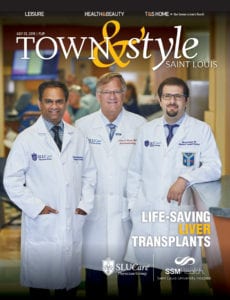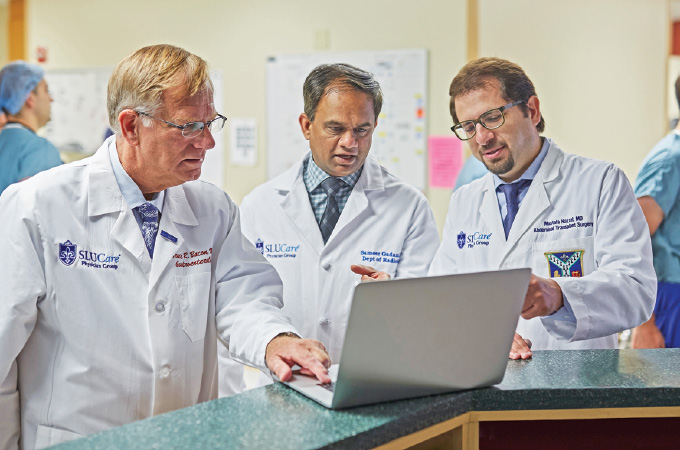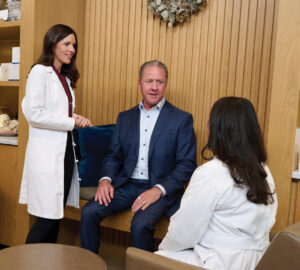Many patients turn to SLUCare Physician Group for life-saving help, including those with serious liver disease who may need a transplant. The practice is one of just a few in the nation performing a reno-portal shunt procedure that makes transplant surgery possible for people who have cirrhosis of the liver and might not otherwise be candidates, says SLUCare surgeon Dr. Mustafa Nazzal.
Cirrhosis, scarring in the liver that prevents the organ from working properly, is caused by a number of conditions, including viral hepatitis, fatty liver disease and chronic alcohol use. Some patients with cirrhosis develop portal vein thrombosis (PVT), clotting in the portal vein that supplies most of the blood flow from the small intestine to the liver. This can prevent the person from getting a transplant, says Nazzal, who practices at SSM Health Saint Louis University Hospital. When a patient develops PVT, the body compensates by ‘rerouting’ the flow of blood through other vessels. Nazzal says it’s important to solve the problem to clear the way for transplant surgery. “If there is total blockage of the vein, we can’t use it as the inflow blood supply for the new liver,” he explains. “We have to look at other options.”
 The liver plays a critical role in healthy metabolism and clearing toxins from the body, Nazzal explains. When a patient first comes in, the team of knowledgeable specialists performs lab tests and a liver ultrasound to check the function of blood vessels connected to it. Doctors also may order a CT scan or MRI to look for clots. “We can evaluate the patient’s fitness for transplant using the MELD (Model for End-Stage Liver Disease) scale,” Nazzal says. “If the score is less than 20, our interventional radiology team may be able to go in and remove the clot. But if it’s above 20, the patient may need the reno-portal shunt, which uses grafted tissue from the left kidney vein to create an alternative inflow for the donated liver.”
The liver plays a critical role in healthy metabolism and clearing toxins from the body, Nazzal explains. When a patient first comes in, the team of knowledgeable specialists performs lab tests and a liver ultrasound to check the function of blood vessels connected to it. Doctors also may order a CT scan or MRI to look for clots. “We can evaluate the patient’s fitness for transplant using the MELD (Model for End-Stage Liver Disease) scale,” Nazzal says. “If the score is less than 20, our interventional radiology team may be able to go in and remove the clot. But if it’s above 20, the patient may need the reno-portal shunt, which uses grafted tissue from the left kidney vein to create an alternative inflow for the donated liver.”
The shunt is performed as part of the transplant surgery. “We have found that patients tolerate the shunt well, and the rate of complications is low,” Nazzal says. (The procedure adds about an hour to the transplant surgery, and it may help the patient avoid a more complicated multivisceral transplant, which involves the small bowel and liver.) The idea behind the shunt is to make it safer and more feasible for the patient to have the transplant, Nazzal says. “Our specialists in surgery, hepatology and interventional radiology work as a group to review patients’ test results and imaging,” he says. “Then we work together to tailor the best treatment.”
Police officer Val Krause underwent the shunt procedure recently, and says the SLUCare team was instrumental in returning him to health. He had a hereditary condition that caused serious liver disease and needed the shunt in order to get a transplant. “I’m back at work and feel like I’m 100 percent,” Krause says of his recovery. “I haven’t felt this good in years. My SLUCare doctors were extremely professional and no-nonsense, and their bedside manner was excellent and personable. To me, they are the real heroes.”
Nazzal says the shunt procedure gives important hope to those who aren’t initially good candidates for a transplant, or who might otherwise need the more complex surgery. “This is one more way we can tailor treatment to the needs of each patient,” he says.
Pictured above: Dr. Bruce Bacon, Dr. Sameer Gadani and Dr. Mustafa Nazzal confer about a patient.
SLUCare Physician Group provides complete, compassionate care for patients with liver disease. Pictured on the cover: SLUCare physicians Dr. Sameer Gadani, Dr. Bruce Bacon and Dr. Mustafa Nazzal. For more information, visit slucare.edu/transplant.
Cover design by Allie Bronsky | Cover photo courtesy of SLUCare Physician Group








